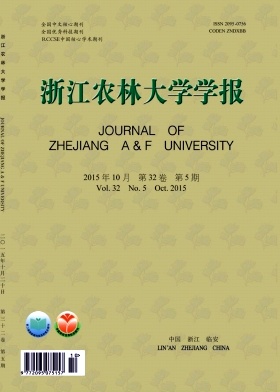Interannual variation of forest cover and albedo in Northern China
doi: 10.11833/j.issn.2095-0756.2015.05.005
国家高技术研究发展计划(863计划)项目(2012AA102001-5)
- Received Date: 2015-02-07
- Rev Recd Date: 2015-04-13
- Publish Date: 2015-10-20
-
Key words:
- forest ecology /
- forest coverage /
- classification /
- land cover /
- albedo /
- Northern China
Abstract: Northern China (above the 35 N latitude) with its vast landmass and a fragile ecological environment has an ecological security affected by variations in forest coverage and albedo. To evaluate the result of ecological development in northern China, land cover types and albedo product data from the moderate-resolution imaging spectroradiometer (MODIS) were collected from 2003 to 2012. Then, spatial and statistical variation of forest coverage and albedo and their relations during a typical summer time phase for this area were analyzed using a spatial and temporal analysis method with the window size of 1 km1 km and the nearest neighbor sampling method. Results indicated that (1) the forest coverage rate increased from 8.5% to 10.3% with a net increase of 1.6% over the 10 years, the forest degradation rate was 1.4%, and the forest rate of increase was 3.0%. The evergreen coniferous forest had the fastest growth rate of 0.002 2 per year, and the mixed forest had the greatest growth of 1.3% during the 10 years. Forest coverage rates in all three climatic zones in the study area were higher in 2012 compared to 2003: from 22.2% to 25.9% in the temperate monsoon climatic zone, from 2.0% to 2.9% in the temperate continental climatic and from 1.0% to 1.4% in the mountain plateau climatic zone. Also, forest variation mainly existed in the Big and Small Xingan Mountains and Changbai Mountain Area, followed by Beijing and surrounding provinces, Shaanxi, Gansu, Ningxia, and the western Xinjiang area. (2) Albedo in the temperate monsoon climatic zone remained unchanged at about 0.150 0. Albedo in the temperate continental climatic and the mountain plateau climatic zones decreased annually to about 0.190 0-0.200 0, and decreased in the mountain plateau climatic zone. (3) Forest increase and degradation mainly occurred between different types of vegetation coverage (forest, grass, and farmland), so albedo variation in summers over the 10 year period was small for unchanged forests (0.007 0), increased forests (-0.003 9), and degraded forests (-0.008 9). Thus, an increase in forest area reduced the albedo for a bare soil surface, and reduced albedo when the coverage changed from other types to evergreen coniferous forest and shrub, indicating that the evergreen coniferous forest and shrub type decreased the albedo, which in turn meant a better energy balance. [Ch, 5 fig. 5 tab. 12 ref.]
| Citation: | ZHAO Jiujia, ZHANG Xiaoli. Interannual variation of forest cover and albedo in Northern China[J]. Journal of Zhejiang A&F University, 2015, 32(5): 683-690. DOI: 10.11833/j.issn.2095-0756.2015.05.005 |









 DownLoad:
DownLoad: